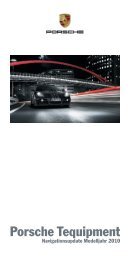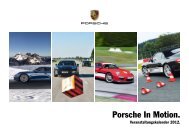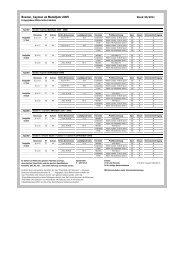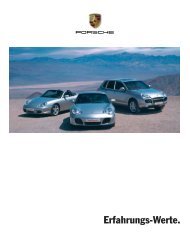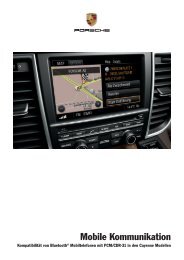Porschenews 03/2008 To the core. The new 911.
Porschenews 03/2008 To the core. The new 911.
Porschenews 03/2008 To the core. The new 911.
You also want an ePaper? Increase the reach of your titles
YUMPU automatically turns print PDFs into web optimized ePapers that Google loves.
<strong>The</strong> Porsche Doppelkupplung (PDK) double clutch transmission<br />
As if one clutch didn’t already provide enough<br />
fun. <strong>The</strong> Porsche Doppelkupplung (PDK)<br />
double clutch transmission.<br />
Multi-plate clutch 1<br />
Engine-/<br />
transmission flange<br />
<strong>The</strong> Porsche Doppelkupplung (PDK) transmission<br />
with both manual gearshift and automatic modes<br />
makes extremely fast gear changes possible without<br />
interrupting power delivery. For clearly improved<br />
acceleration and lower fuel consumption – without<br />
having to sacrifice <strong>the</strong> convenience of a converter<br />
automatic.<br />
Multi-plate clutch 2<br />
Oil pump<br />
Hydraulic control unit<br />
Input shaft 1<br />
Input shaft 2<br />
4th gear 2nd 6 gear<br />
th gear<br />
Drive shaft<br />
Reverse gear<br />
1 st gear<br />
3 rd gear<br />
7 th gear<br />
Main shaft<br />
s <strong>The</strong> Porsche Doppelkupplung (PDK) dual clutch transmission<br />
Switching gears in milliseconds.<br />
<strong>The</strong> <strong>new</strong> PDK, available upon request for all 911<br />
models, is based on a Porsche development and<br />
caused a sensation in Porsche race cars on <strong>the</strong><br />
world’s race tracks back in <strong>the</strong> 80s. <strong>The</strong> <strong>new</strong><br />
PDK has seven gears; in effect two transmissions<br />
5 th gear<br />
integrated into one housing and – as <strong>the</strong> name<br />
suggests – two clutches.<br />
<strong>The</strong> PDK provides an alternating non-positive<br />
connection between <strong>the</strong> gearbox and <strong>the</strong> engine by<br />
means of two separate drive shafts (drive shaft 1<br />
is inside <strong>the</strong> hollowed out drive shaft 2). <strong>The</strong> power<br />
transmission of <strong>the</strong> engine thus always runs over<br />
one partial transmission and one clutch, while <strong>the</strong><br />
next gear is already engaged in <strong>the</strong> second partial<br />
transmission. So, when switching gears, shifting no<br />
longer takes place, ra<strong>the</strong>r as one clutch is opened,<br />
<strong>the</strong> o<strong>the</strong>r is closed at <strong>the</strong> same time. Gear changes<br />
<strong>the</strong>refore take place within milliseconds. Clutch 1<br />
serves <strong>the</strong> first partial transmission with <strong>the</strong> odd-<br />
numbered gears (1, 3, 5, 7) as well as <strong>the</strong> reverse<br />
gear. Clutch 2 operates <strong>the</strong> second partial transmis-<br />
sion with <strong>the</strong> even-numbered gears (2, 4, 6).<br />
<strong>The</strong> operating principle.<br />
<strong>The</strong> crankshaft transfers <strong>the</strong> engine torque to <strong>the</strong><br />
damped flywheel. <strong>The</strong>n it is guided over <strong>the</strong> clutch<br />
housing to <strong>the</strong> multi-disc clutch – to be more precise<br />
to <strong>the</strong> respective outer slat members. By means of<br />
t <strong>The</strong> gears can be changed using switches directly on <strong>the</strong> PDK steering wheel<br />
oil pressure, clutch 1 closes and creates a power<br />
transmission with drive shaft 1.<br />
<strong>The</strong> PDK has already preselected <strong>the</strong> next gear.<br />
<strong>The</strong> engine torque already bears against <strong>the</strong> o<strong>the</strong>r<br />
outer slat member: at <strong>the</strong> signal for a gear shift, <strong>the</strong><br />
overlapping shifting takes place, i.e. while clutch 1<br />
opens, clutch 2 closes. <strong>The</strong> power transmission with<br />
drive shaft 2 is produced, which transfers <strong>the</strong> power<br />
to <strong>the</strong> wheels.<br />
<strong>The</strong> advantage of <strong>the</strong> PDK is extremely fast gear<br />
changes without interruption of power delivery,<br />
for improved acceleration ratios. <strong>The</strong> driving<br />
experience is even more sporty and dynamic, and<br />
agility is increased. <strong>The</strong> compact dimensions of <strong>the</strong><br />
transmission reduce <strong>the</strong> rotating masses. <strong>The</strong> result:<br />
a more direct response from <strong>the</strong> engine and a lower<br />
system weight. <strong>The</strong> very high level of efficiency and<br />
<strong>the</strong> long ratio 7 th gear contribute to achieving lower<br />
fuel consumption ratios and emissions – comparable<br />
to that of a manual transmission. <strong>To</strong>ge<strong>the</strong>r with<br />
<strong>the</strong> <strong>new</strong> engines, it was possible to reduce fuel<br />
consumption by up to 13%, depending on <strong>the</strong><br />
model, and CO 2 emissions by up to 15%. n







